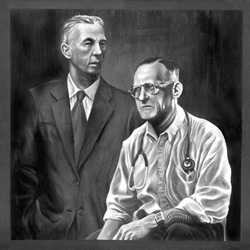Thank you for your interest in Alcoholics Anonymous. Below are links to AA pamphlets that explain our recovery program and give a general idea of how AA works. You will see that the first and most important step in our program is admission by the alcoholic that he or she is powerless over alcohol and that life has become unmanageable. It is often helpful for the alcoholic to talk with an AA member, because it may make it easier to understand the nature of the illness and to accept AA help.
Alcoholics Anonymous is a program of a new way of life without alcohol, a program that is working successfully for millions of men and women throughout the world, and in all walks of life. The experience of AA members is that alcoholism is a progressive illness that cannot be cured, but which, like some other illnesses, can be arrested—by staying away from the first drink, one day at a time.
We would encourage you to get in touch with the Central Office of Western Colorado to get further information on Alcoholics Anonymous, speak to an AA member or find local AA meetings.
AA members, as volunteers, are happy to offer help by sharing their experience, strength and hope in staying sober. One of the ways members stay sober is by helping other alcoholics to achieve sobriety.
AA Pamphlets
Learn More about Alcoholics Anonymous by download the following literature.
Is AA for You?
Frequently Asked Questions About AA
A Newcomer Asks
A Message To Teenagers
Is There an Alcoholic in Your Life?
Information on Alcoholics Anonymous
About Alcoholism
The first thing we have learned about alcoholism is that it is one of the oldest problems in  history. Only recently have we begun to benefit from new approaches to the problem. Doctors today, for example, know a great deal more about alcoholism than their predecessors knew only a generation ago. They are now just beginning to define the problem and study it in detail.
history. Only recently have we begun to benefit from new approaches to the problem. Doctors today, for example, know a great deal more about alcoholism than their predecessors knew only a generation ago. They are now just beginning to define the problem and study it in detail.
While there is no formal definition of alcoholism in AA, the majority of our members agree that, for most of us, it could be described as a physical compulsion, coupled with a mental obsession.
What we mean is that we had a distinct physical desire to consume alcohol beyond our capacity to control it, in defiance of all rules of common sense. We not only had an abnormal craving for alcohol but we frequently yielded to it at the worst possible times. We did not know when or how to stop drinking. Often we did not seem to have sense enough to know when not to begin.
As alcoholics, we have learned the hard way that willpower alone, however strong in other respects, was not enough to keep us sober.
We have tried going on the wagon for specific periods. We have taken solemn pledges. We have switched brands and beverages. We have tried drinking at only certain hours. But none of our plans worked. We always wound up, sooner or later, getting drunk when we not only wanted to stay sober and had every rational incentive to do so.
We have gone through stages of dark despair when we were sure that something was wrong with us.
We came to hate ourselves for wasting the talents with which we were endowed and for the trouble we were causing our families and others. Frequently, we indulged in self-pity and proclaimed that nothing could ever help us. We can smile at those recollections now but at the time they were grim, unpleasant experiences.
Today we are willing to accept the idea that, as far as we are concerned, alcoholism is an illness – a progressive illness that can never be cured but which, like some other illnesses, can be arrested.
We agree that there is nothing shameful about having an illness, provided we face the problem honestly and try to do something about it. We are perfectly willing to admit that we are allergic to alcohol and that it is simply common sense to not put something in our body that we are allergic to.
We understand now, that once a person has crossed the invisible line from heavy drinking to compulsive alcoholic drinking, they will always remain alcoholic. So far as we know, there can never be any turning back to normal social drinking. Once an alcoholic – always an alcoholic is a simple fact we have to live with. We have also learned that there are few alternatives for the alcoholic. If they continue to drink, their problem will become progressively worse.
They seems assuredly on the path to the gutter, to hospitals, to jails or other institutions, or to an early grave. The only alternative is to stop drinking completely and to abstain from even the smallest quantity of alcohol in any form. If they are willing to follow this course and to take advantage of the help available to them, a whole new life can open up for the alcoholic.
History of AA
 A seemingly unplanned meeting in Akron, Ohio in 1935 between two men, both of whom were termed hopeless alcoholics, began a program of recovery that has helped millions find sobriety.
A seemingly unplanned meeting in Akron, Ohio in 1935 between two men, both of whom were termed hopeless alcoholics, began a program of recovery that has helped millions find sobriety.
Bill W. was one of these men. In fighting his own battle against drinking, he had already learned that helping other alcoholics was the key to maintaining his own sobriety, the principle that would later become step twelve in the Twelve Steps of Alcoholics Anonymous.
A stock broker from New York City, Bill W. had traveled to Akron, Ohio on May 12, 1935 for a shareholders’ meeting and proxy fight, which did not turn out his way. Fighting desperately to maintain his sobriety, his immediate reaction was to help another alcoholic.
A few inquiries lead him to a meeting with an Akron surgeon, forever to be remembered simply as Dr. Bob, who had struggled for years with his own drinking problem.
The effect the meeting had on Dr. Bob was immediate and soon he too put down the bottle, never to pick it up again. The bond formed between the two men would grow into a movement that would literally affect the lives of millions.
Starting in an upstairs room at Dr. Bob’s home in Akron, Ohio the two men began helping alcoholics, one person at a time.
It took four years to get the first 100 alcoholics sober in the first three groups that formed in Akron, New York, and Cleveland. But after the publication in 1939 of the group’s text book Alcoholics Anonymous and the publication of a series of articles about the group in the Cleveland Plain Dealer, the development of AA was rapid. Membership in the Cleveland group soon grew to over 500 members.
The response was so overwhelming, the group found itself sending out members, who had only a short time in the program themselves, to work with other new members.
After a dinner in New York in 1940, given by John D. Rockefeller, Jr., to publicize the group, membership soon grew to 2,000. An article in the Saturday Evening Post in 1941 resulted in another growth period and membership in the United States and Canada rose to 6,000 members.
Today, there are over 2,000,000 members of Alcoholics Anonymous worldwide in 180 countries. Additionally, its program of recovery serves as a model for many other 12 Step Fellowships. There have been more than 25,000,000 copies of English version of The Big Book distributed.
AA Meetings
There are over 1,200+ meetings that occur monthly in Western Colorado.
There are many different types of meetings and meeting formats where AA members share their experience, strength and hope with anyone seeking help with a drinking problem. These same AA Members also offer sponsorship to those that are new to Alcoholics Anonymous.
Generally, AA meetings fall into two types of meetings – Open and Closed. Anyone may attend an open AA meeting, but only those with a drinking problem may attend closed meetings. There are men and women only AA meetings that are also closed meetings as well.
Those wanting to learn more about AA are always welcome to attend an Open Meeting in the area.
At Open Speaker Meetings, AA members tell their stories describing their experiences with alcohol, how they came to AA and how their lives have changed as a result of Alcoholics Anonymous.
At Open Discussion Meetings, an AA member speaks briefly about his or her drinking experience and then leads a discussion on AA recovery or any drinking-related problem that anyone may bring up.
Closed Discussion Meetings are conducted just as open discussions are, but for alcoholics or someone that thinks they may have a drinking problem.
Step meetings focus on discussions of one of the Twelve Steps of Alcoholics Anonymous.
AA members also take meetings into correctional and treatment facilities.
AA members may be asked to conduct the informational meetings about AA. These meetings about AA are not regular AA group meetings.
What AA Doesn’t Do
- Furnish initial motivation for alcoholics to recover
- Solicit members
- Engage in or sponsor research
- Keep attendance records or case histories
- Join councils of social agencies
- Follow up or try to control its members
- Make medical or psychological diagnoses or prognoses
- Provide drying-out or nursing services, hospitalization, drugs, or any medical or psychiatric treatment
- Offer religious services or host/sponsor retreats
- Engage in education about alcohol
- Provide housing, food, clothing, jobs, money, or any other welfare or social services
- Provide domestic or vocational counseling
- Accept any money for its services, or any contributions from non AA sources
- Provide letters of reference to parole boards, lawyers, court officials, social agencies, employers, etc.
- Provide progress reports on court clients to the referring agency
- Provide recovery for addictions other than alcohol ie. drugs, gambling, overeating etc.

